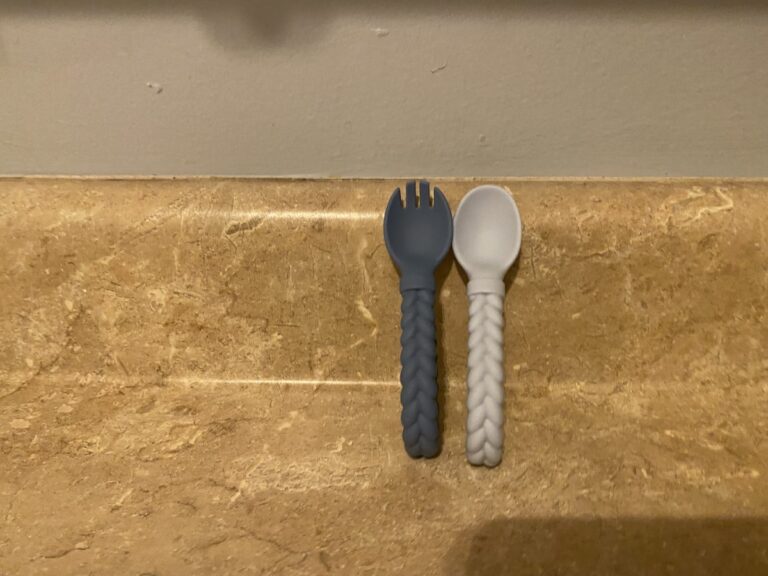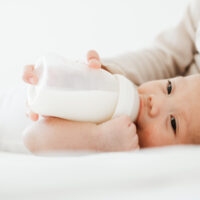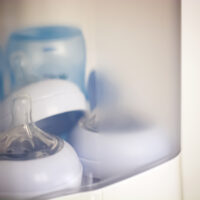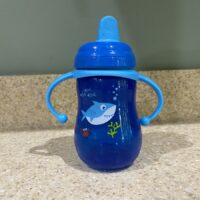As you start to delve into the world of baby food you may be wondering, how do I teach my baby to use a spoon? Whether just starting solid foods or working with an independent toddler, the steps look pretty similar.
While there is no right or wrong answer, we’ve put some tips together to help you determine when to introduce utensils and what steps to take to make sure your baby is on track for learning how to successfully use a spoon.
Set yourself up for success by learning what to expect and what steps to take. We’ve also rounded up our recommended products that can make teaching your baby how to use a spoon as successful and stress-free as possible.
What can I expect when teaching my baby how to use a spoon?
You should expect a mess, regardless of the age of your baby learning to use a spoon is going to be a messy process. But, if you go into it knowing there will be a mess it can be easier to handle. Expect to keep things fun, positive and playful, if it starts to get stressful take a break.
Learning how to use a spoon will involve a learning curve, for both you and baby, but practice makes perfect. You should not expect to give your baby a spoon for every meal, but try to introduce it at least once a day when you are starting out. At the beginning stages of learning how to use a spoon, it is about exposure, as your baby becomes accustomed to the new tool they will start to grasp the concept more and more.
We suggest entering the spoon-feeding process with low expectations, a baby will not be independently feeding themselves from a spoon quickly, but the consistent exposure will definitely help the process. Go into mealtime with a positive attitude, remain calm, embrace the mess, and keep practicing!
When should my baby be able to use a spoon?
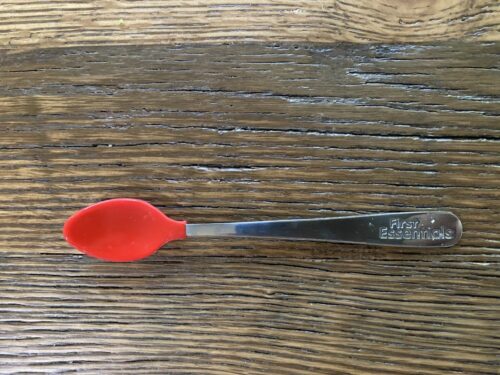
We recommend introducing a spoon early on in the feeding process, however, most indicators show that children are able to successfully master feeding themselves with a spoon and no additional support by age 2. Different textured foods have different difficulty levels, for instance, a baby will likely be able to scoop and eat yogurt before they are able to scoop and eat applesauce or soup. Start with thick foods to give your baby the confidence they need to persevere with thinner food.
Even though a child may not be able to fully master independent spoon feeding until age two, that doesn’t mean you should wait to introduce the concept. Beginning as early as you start solid foods, and even utilizing modeling before then, is a good way to practice and solidify it as a habit. Babies learn by observing, and if they watch you enjoy your meal by using a spoon, they will be that much more ready to try on their own when the time is right.
Starting with a pre-spoon is a great beginning step. A baby does not need to have the motor control to scoop with pre-spoons, but they will still get the hand-eye coordination practice and satisfaction of being able to independently feed themselves. You can find more information on pre-spoons in our recommended products section.
My baby is a mess! Is it worth it?
Absolutely! Babies learn through doing, and using a spoon is good for so much more learning than just self-feeding. You can also expect additional learning outcomes such as independence, fine motor development, hand-eye coordination, and a further development of their senses.
Independence
The newfound independence that comes with a baby feeding themselves is not only great for developing their sense of self, but will also give you some free time to enjoy your own meal. If your baby has an independent streak, being able to feed themselves will give them a sense of accomplishment and satisfaction.
Fine Motor Development
Using a spoon will help babies work on the small muscles in their hands, further developing their fine motor skills. It is important for babies to develop their fine motor skills in order to learn how to grab and grasp and manipulate smaller objects. Incorporating spoon use into mealtimes is a positive, stress-free way for babies to work on those small muscles without even realizing they are working. The reward is something yummy to eat, which can be a great motivator.
Hand-Eye Coordination
Your baby will also be developing their hand-eye coordination as they work to find the bowl with their spoon, and then find their mouth with the loaded spoon. Learning how to focus on an object and manipulate it the right way is a huge learning milestone and is used for much more than just eating. Mealtime is a great time to incorporate this practice and again, the food can be an enticing motivator.
Sensory Development
Even though the mess can be painful for some of you, babies learn to develop their senses by playing, squishing, and splatting their food. Touch is an important sense, and it’s important to allow your baby the freedom to fully explore their meal and engage all of their senses. If you’re offering multiple types of food all the squishing and mixing can lead to new flavors, which also helps your baby develop their sense of smell and taste along with their sense of touch as they explore the various textures.
If you’re feeling overwhelmed, set boundaries for yourself, and don’t feel like you always have to embrace the mess. Especially when you are just starting out don’t feel obligated to have your baby practice spoon feeding for every meal, or limit it to shorter introduction time frames so that the mess is not too overwhelming. Starting out once a day is great exposure and practice, maybe the mealtime that will naturally be followed by a bath. In our recommended products we also have great bib suggestions that can help limit some of the mess.
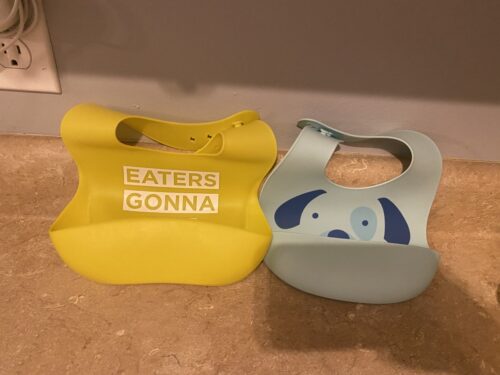
How to Teach Baby to Use a Spoon
1. Model Utensil Use
If you’re not sure how to teach baby to use a spoon, start with natural learning opportunities. Even if your baby is too little to join in on eating during meal time, that doesn’t mean that they can’t benefit from watching. Have your baby join you at the table during meals, they will get to observe the family using utensils for eating, which will begin to plant the foundation for mealtime even before they are eating their own solid foods. Modeling what using a spoon looks like is a great first step to teaching your baby how to use a spoon.
As babies grow and develop they love to imitate. Let them practice imitating you using a spoon, or pretend to feed a baby doll and let your child imitate the motions with a plastic spoon. As they observe and watch you eat, you may find them imitating the process of using a spoon, which is also a great way to develop the actual skills.
2. Let them Explore
When you’re figuring out how to teach baby to use a spoon, the second step is to let them explore a spoon while you continue to feed them. Your baby will begin to associate the spoon with eating and food, even though they don’t yet have the coordination to do it themselves. Give them one spoon to play with and explore, while you use another spoon to feed them their meal.
As they explore the new object you may find them starting to bring it to their mouth, even though there is no food on their spoon they are starting the beginning stages of learning what this tool is used for. Be encouraging and positive as they find their mouth to let them know that they are doing the right thing!
3. Pre-Load the Spoon
Now that your baby has observed you using a spoon, and has been able to explore the spoon themselves, it’s time to give them the satisfaction of getting food into their mouth, without the frustration of trying to scoop themselves. Pre-load the spoon and leave it on their plate or highchair tray, as they pick it up encourage them to find their mouth.
At this stage you are still feeding the baby most of their meal, but this is about giving them exposure and practice with gripping their spoon and finding their mouth. If you find that your baby doesn’t want to give up their spoon, keep more than one available so that you can keep swapping a new preloaded one out for the empty one.
Start with thicker foods like yogurt or oatmeal that will not easily slide off of the spoon. Pre-spoons like ChooMee Baby Spoons are great for pre-loading and leaving for your baby to explore.
4. Introduce Their Own Bowl
Now it’s time to give the baby their own bowl with a little bit of food inside, to begin practicing scooping and finding their mouth. Typically you still would have your own bowl and are feeding your baby most of their meal, but this is a great opportunity for them to practice the steps to getting food on their spoon and putting it in their mouth.
Be prepared for a mess, remember to maintain your patience, keep things fun, and don’t feel like you need to do this for every meal, even once a day is a great start. Only place a little bit of food in the bowl to start so if it gets tipped over it’s no big deal. We like bowls with a suction bottom to help with stability.
5. Hand Over Hand
If your baby will tolerate the help, you can practice scooping from the bowl and bringing the spoon to their mouth by using a hand over hand technique. You can walk your baby through the steps of how to hold their spoon, rotate their hand to the bowl, and lift up to their mouth to create a successful eating process.
Depending on your child’s age, they may or may not tolerate the help. If their independent streak is coming out don’t force the process, you want to keep mealtimes positive and fun. If your baby will accept the help, the hand over hand process provides them with stability while creating a foundation for the necessary steps to using a spoon, and will give them the satisfaction of being successful at each bite.
6. Independent Feeding
By this stage, your baby should be ready to feed themselves, with the occasional help from you for bigger bites or if their spoon gets twisted around. You can still expect things to be pretty messy, but your baby should be getting the majority of their food in their mouth without too much frustration.
As your baby becomes independent with thicker foods and more confident in their ability to use a spoon you can start to introduce thinner foods such as applesauce or soups. Pretty soon they will be able to navigate any food because of the foundation you have set.
You might not get to the independent stage of feeding for months, and that’s okay. Keep practicing and the more your baby grows and develops the easier self-feeding will become.
Products We Recommend for Teaching Baby How to Use a Spoon
There are no special utensils that you need to have, but there are some we recommend that will make the process easier and more successful. However, as long as they are safe and supervised, regular utensils are fine to use as well.
ChooMee Baby Spoon
When you are just starting to teach baby to use a spoon, we recommend a pre-spoon, such as the ChooMee Baby Spoon. These are small-sized, perfect for little hands, and have a flat head which means there’s no wrong way to hold it and you don’t have to worry about continuing to turn around a spoon for babies to be able to successfully scoop. The soft-textured surface is perfect for teething on, and you don’t have to worry about new teeth chomping down on a metal spoon. The design of these pre-spoons mean that babies don’t need to scoop to get food, they just need to dip their spoon in the food, and the ridges will trap enough food for them to successfully self-feed.
Grabease Utensils
As your baby becomes more accustomed to spoon use, we recommend the Grabease utensils. The handles are designed specifically to fit into little hands while encouraging proper grip (which helps with pre-writing skills), and there is a specifically designed choke shield which prevents baby from putting the spoon too far into their mouth inducing gagging. The shallow spoon make it easy for babies to successfully scoop and eat the food off.
Bumkins Spoon and Fork Set
Once your baby has really gotten the hang of things, we recommend utensils such as the Bumkins spoon and fork set. Designed for toddlers, 18+ months, these utensils have stainless steel heads and silicone handles. They are the perfect size for toddlers making them easy to manipulate and provide successful eating outcomes.
Silicone and/or Sleeved Bibs
Other nice to have products you may want to invest in are bibs and suction bowls. We like silicone bibs and sleeved bibs. Depending on how much mess you’re really up for, sleeved bibs might be the way to go. The sleeved bibs are great for preserving outfits, the long sleeves offer full coverage. Silicone bibs have a catchall pocket great for food drips and are easy to clean and maintain as you teach baby to use a spoon.
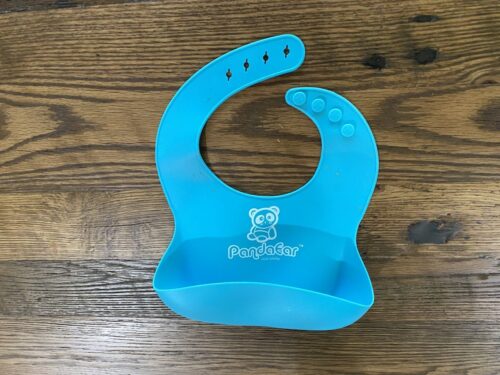
Suction Bottom Bowls
When you teach baby to use a spoon, investing in some bowls with a suction cup on the bottom might come in handy. The suction base will prevent a bowl from tipping over or sliding around as your baby works to scoop food out. As many babies like to throw things off their tray, the suction bottom will also help deter this unwanted behavior.
Final Word
Learning how to teach baby to use a spoon does not have to be complicated. We recommend starting with a spoon instead of a fork because it is easier to successfully accomplish. Enjoy family mealtimes together as your baby practices their new skill and observes other family members also using utensils to feed themselves.
Remember to stay patient and keep mealtimes fun and playful. If the mess is overwhelming to you, limit spoon exposure to short periods of time or one meal a day. Consistent exposure is important, but your baby likely will take months to independently begin self-feeding from a spoon. They will learn from observing and practicing, but also need to have developed fine motor skills and hand-eye coordination to actually manipulate a spoon.
Providing your baby with their own set of utensils is important for them to learn independence. The right spoons can be used for soothing sore gums as well as for eating. As your baby grows and develops, adjust their eating utensils to help them be successful.
Eating and mealtime should be positive experiences. Enjoy the time with your baby as they discover more about themselves and the world around them. Encouraging good eating habits from the beginning will help develop lifelong skills and memories surrounding food.
